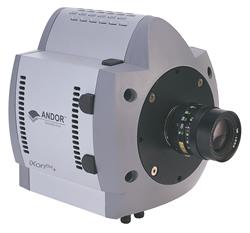Jul 31 2010
Andor Technology’s EMCCD cameras have been deployed to help a US research team in redefining the optical microscopy boundaries. The research team comprises Steven Chu, Yunxiang Zhang, and Alexandro Pertsinidis.
One of the two cameras is the Andor iXonEM+ 897 model that helps in individual photon capturing from single fluorescence emitters. The other camera is the iXonEM+ 860 that can capture images at the rate of 500 frames per second.
 Andor iXon EM+ 897 Camera
Andor iXon EM+ 897 Camera
The research team, by creating an alert feedback system, was able to position the centroid of one fluorescent molecule image at any place on any CCD array of the camera and then measure the position of the image with sub-pixel accuracy. Consequently, the conventional errors that are caused by non-uniformity while manufacturing the chip are decreased to sub-nanometer level.
The team developed a single molecule, two-color imaging system that attained image resolutions magnitude greater than the present 5nm resolution techniques. As it resolves single fluorescent molecules at this level, the system will have considerable implications for biological research.
The research team is planning to use this technique to study more details about the human RNA polymerase II system. The RNA system initiates the DNA transcription, and the molecular mechanisms that control the cell-to-cell adhesion processes.